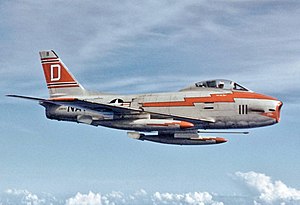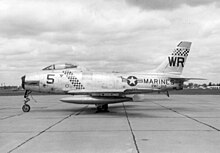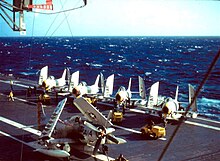
The McDonnell FH Phantom is a twinjet, straight-wing, carrier-based fighter aircraft designed and first flown during late World War II for the United States Navy. As a first-generation jet fighter, the Phantom was the first purely jet-powered aircraft to land on an American aircraft carrier and the first jet deployed by the United States Marine Corps. Although only 62 FH-1s were built it helped prove the viability of carrier-based jet fighters. As McDonnell's first successful fighter, it led to the development of the follow-on F2H Banshee, which was one of the two most important naval jet fighters of the Korean War; combined, the two established McDonnell as an important supplier of navy aircraft.

The McDonnell F2H Banshee is a single-seat carrier-based jet fighter aircraft designed and produced by the American aircraft manufacturer McDonnell Aircraft. It was an early jet fighter operated by United States Navy and United States Marine Corps, as well as being the only jet-powered fighter to ever be deployed by the Royal Canadian Navy. The aircraft's name is derived from the banshee of Irish mythology.
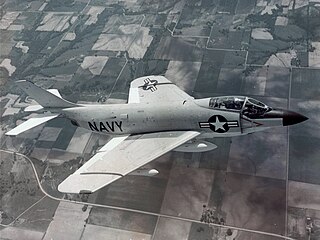
The McDonnell F3H Demon is a subsonic swept-wing carrier-based jet fighter aircraft designed and produced by the American manufacturer McDonnell Aircraft Corporation. It was the first swept wing jet fighter and the only single-engined carrier-based fighter the company produced.
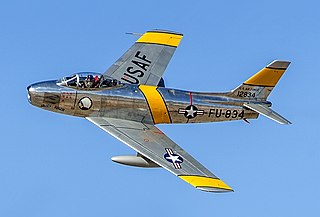
The North American F-86 Sabre, sometimes called the Sabrejet, is a transonic jet fighter aircraft. Produced by North American Aviation, the Sabre is best known as the United States' first swept-wing fighter that could counter the swept-wing Soviet MiG-15 in high-speed dogfights in the skies of the Korean War (1950–1953), fighting some of the earliest jet-to-jet battles in history. Considered one of the best and most important fighter aircraft in that war, the F-86 is also rated highly in comparison with fighters of other eras. Although it was developed in the late 1940s and was outdated by the end of the 1950s, the Sabre proved versatile and adaptable and continued as a front-line fighter in numerous air forces.

The Grumman F11F/F-11 Tiger is a supersonic, single-seat carrier-based fighter aircraft designed and produced by the American aircraft manufacturer Grumman. For a time, it held the world altitude record of 76,939 feet (23,451 m), as well as being the first supersonic fighter to be produced by Grumman.

The Grumman F9F Panther is an early carrier-based jet fighter designed and produced by the American aircraft manufacturer Grumman. It was the first jet-powered fighter aircraft to see air-to-air combat with the United States Navy as well as being Grumman’s first jet fighter.
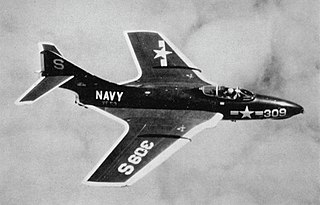
The Grumman F9F/F-9 Cougar is a carrier-based jet-powered fighter aircraft designed and produced by the American aircraft manufacturer Grumman.

The General Electric J47 turbojet was developed by General Electric from its earlier J35. It first flew in May 1948. The J47 was the first axial-flow turbojet approved for commercial use in the United States. It was used in many types of aircraft, and more than 30,000 were manufactured before production ceased in 1956. It saw continued service in the US military until 1978. Packard built 3,025 of the engines under license.
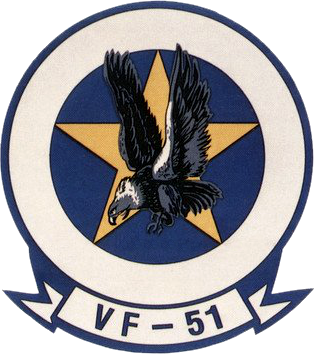
VF-51, Fighter Squadron 51 was an aviation unit of the United States Navy known as the "Screaming Eagles". It was originally established as VF-1 on 1 February 1943, redesignated as VF-5 on 15 July 1943, redesignated as VF-5A on 15 November 1946, redesignated VF-51 on 16 August 1948, and disestablished in March 1995. Until its disestablishment, VF-51 was the oldest fighter squadron in continuous service with the Pacific Fleet.

Fighter Squadron 143 or VF-143, also known as the World Famous Pukin' Dogs, is an aviation unit of the United States Navy originally established as a Naval Reserve squadron VF-821 on 20 July 1950. It was redesignated VF-143 on 4 February 1953 and deactivated on 1 April 1958. In June 1962, the squadron was reactivated, and currently is flying the F/A-18E as part of Carrier Air Wing 7 at Naval Air Station Oceana.

Fighter Squadron 194 (VF-194) was an aviation unit of the United States Navy. It was originally established as VF-91 on 26 March 1952, redesignated VF-194 on 1 August 1963 and disestablished on 1 March 1978. It was the third US Navy squadron to be designated VF-194.

Marine Fighter Attack Training Squadron 501 (VMFAT-501) is a training squadron in the United States Marine Corps, consisting of 27 F-35B Lightning II aircraft and serves as the Fleet Replacement Squadron. Known as the "Warlords," the squadron is based at Marine Corps Air Station Beaufort, South Carolina and falls administratively under Marine Aircraft Group 31 and the 2nd Marine Aircraft Wing. The squadron has assumed the lineage of VMFA-451 which was originally known as the "Blue Devils" and saw action during World War II and Operation Desert Storm. They were decommissioned on 31 January 1997.

The Yanks Air Museum is an aviation museum dedicated to exhibiting, preserving and restoring American aircraft and artifacts in order to show the evolution of American aviation, located at Chino Airport in Chino, California.

The USS Midway Museum is a historical naval aircraft carrier museum in San Diego, California, located at Navy Pier. The museum consists of the aircraft carrier Midway. The ship houses an extensive collection of aircraft, many of which were built in Southern California.

The North American FJ-1 Fury is an early turbojet-powered carrier-capable fighter aircraft used by the United States Navy (USN). Developed by North American Aviation (NAA) starting in 1945, it became the first jet aircraft in USN service to serve at sea under operational conditions. This first version of the FJ was a straight-winged jet, briefly operational during the transition to more successful designs. An evolution of the FJ-1 would become the land-based XP-86 prototype of the United States Air Force's enormously influential F-86 Sabre, which in turn formed the basis for the Navy's carrier-based, swept-winged North American FJ-2/-3 Fury.

The North American FJ-4 Fury is a swept-wing carrier-capable fighter-bomber for the United States Navy and Marine Corps. The final development in a lineage that included the Air Force's F-86 Sabre, the FJ-4 shared its general layout and engine with the earlier FJ-3, but featured an entirely new wing design and was a vastly different design in its final embodiment.
North American FJ Fury may refer to several members of a group of fighter and fighter-bomber aircraft, built by North American Aviation for the US Navy, and related in varying degrees to the F-86 Sabre this firm produced for the US Air Force:

VF-121 of the US Navy was a former Pacific Fleet Replacement Air Group (RAG) unit. Originally established on 1 July 1946, as VF-781, it was redesignated as VF-121 on 4 February 1953 and disestablished on 30 September 1980. On 11 April 1958 it changed duty from Fleet Squadron to Fleet Replacement Squadron and was later charged with the training of Navy F-4 Phantom flight and maintenance crews.
VC-10 Composite SquadronChallengers was a United States Navy aircraft squadron. It was originally known as the Mallards in 1943, but when assigned the F-8 Crusader the squadron pilots unofficially used the name "Challengers". The squadron was formally known as the Challengers from 1961 through 1993.
